Harnessing ICT Resources to Enhance Community Disaster Resilience: A Case Study of Employing Social Media to Zhengzhou 7.20 Rainstorm, China
Abstract
1. Introduction
2. Theoretical Background
2.1. ICT Resources and Disaster Resilience
2.2. Social Media and Community Disaster Resilience
3. Materials and Methods
3.1. Data Sources
3.2. Measurement of the Variables
3.3. Data Analysis
4. Results
4.1. Choice of Social Media Platform
4.2. Overall Satisfaction of People Using the Three Social Media Platforms
4.3. Social Media Scores for Each Variable
4.4. Differences between WeChat, TikTok, and Weibo According to Sociodemographic Characteristics
4.5. Regression Analysis
5. Discussion
5.1. Implications and Suggestions
5.2. Limitations
6. Conclusions
- (1)
- The use of WeChat, TikTok, and Weibo had positive effects on community disaster resilience. Specifically, the use of social media by the general public (WeChat, TikTok, and Weibo) during this rainstorm disaster was positively related to convenience and trust, creation and dissemination, emotion and communication, cooperation and collective action, and relief and release.
- (2)
- From the results of a comparative analysis of the specific differences in the use of these three social media platforms, it appears that TikTok was used by the largest number of people during the storm disaster. The highest level of user satisfaction was found among those who used WeChat, while the variable scores for TikTok was not the highest. Instead, WeChat had the highest variable scores, and the number of users and variable scores for Weibo were both in the middle. There were also sociodemographic differences between the users of the three types of social media.
Author Contributions
Funding
Data Availability Statement
Conflicts of Interest
Abbreviations
| ICT | Information and communication technology |
References
- Field, C.B.; Barros, V.; Stocker, T.F.; Dahe, Q. Managing the Risks of Extreme Events and Disasters to Advance Climate Change Adaptation: Special Report of the Intergovernmental Panel on Climate Change; Cambridge University Press: Cambridge, UK, 2012. [Google Scholar]
- Alcántara-Ayala, I. Geomorphology, Natural Hazards, Vulnerability and Prevention of Natural Disasters in Developing Countries. Geomorphology 2002, 47, 107–124. [Google Scholar] [CrossRef]
- Guinau, M.; Pallàs, R.; Vilaplana, J.M. A Feasible Methodology for Landslide Susceptibility Assessment in Developing Countries: A Case-Study of NW Nicaragua after Hurricane Mitch. Eng. Geol. 2005, 80, 316–327. [Google Scholar] [CrossRef]
- Disaster Investigation Team of the State Council. Investigation Report on “7.20” Heavy Rainstorm Disaster in Zhengzhou, Henan. 2022. Available online: https://www.mem.gov.cn/gk/sgcc/tbzdsgdcbg/202201/P020220121639049697767.pdf (accessed on 15 May 2022).
- Zhai, L.; Lee, J.E. Analyzing the Disaster Preparedness Capability of Local Government Using AHP: Zhengzhou 7. 20 Rainstorm Disaster. Int. J. Environ. Res. Public. Health 2023, 20, 952. [Google Scholar] [CrossRef]
- Orencio, P.M.; Fujii, M. A Localized Disaster-Resilience Index to Assess Coastal Communities Based on an Analytic Hierarchy Process (AHP). Int. J. Disaster Risk Reduct. 2013, 3, 62–75. [Google Scholar] [CrossRef]
- Lyu, H.-M.; Zhou, W.-H.; Shen, S.-L.; Zhou, A.-N. Inundation Risk Assessment of Metro System Using AHP and TFN-AHP in Shenzhen. Sustain. Cities Soc. 2020, 56, 102103. [Google Scholar] [CrossRef]
- Lyu, H.-M.; Shen, S.-L.; Yang, J.; Yin, Z.-Y. Inundation Analysis of Metro Systems with the Storm Water Management Model Incorporated into a Geographical Information System: A Case Study in Shanghai. Hydrol. Earth Syst. Sci. 2019, 23, 4293–4307. [Google Scholar] [CrossRef]
- Zheng, Q.; Shen, S.-L.; Zhou, A.; Lyu, H.-M. Inundation Risk Assessment Based on G-DEMA℡-AHP and Its Application to Zhengzhou Flooding Disaster. Sustain. Cities Soc. 2022, 86, 104138. [Google Scholar] [CrossRef]
- National Research Council. Applications of Social Network Analysis for Building Community Disaster Resilience: Workshop Summary; National Academies Press: Washington, DC, USA, 2009; p. 12706. ISBN 978-0-309-14094-2. [Google Scholar]
- Varda, D.M.; Forgette, R.; Banks, D.; Contractor, N. Social Network Methodology in the Study of Disasters: Issues and Insights Prompted by Post-Katrina Research. Popul. Res. Policy Rev. 2009, 28, 11–29. [Google Scholar] [CrossRef]
- Cui, P.; Li, D. A SNA-Based Methodology for Measuring the Community Resilience from the Perspective of Social Capitals: Take Nanjing, China as an Example. Sustain. Cities Soc. 2020, 53, 101880. [Google Scholar] [CrossRef]
- Arnold, J.L. Information-Sharing in out-of-Hospital Disaster Response: The Future Role of Information Technology. Prehospital Disaster Med. 2004, 19, 201–207. [Google Scholar] [CrossRef]
- Madon, S.; Reinhard, N.; Roode, D.; Walsham, G. Digital Inclusion Projects in Developing Countries: Processes of Institutionalization. Inf. Technol. Dev. 2009, 15, 95–107. [Google Scholar] [CrossRef]
- Miscione, G. Telemedicine in the Upper Amazon: Interplay with Local Health Care Practices. MIS Q. 2007, 31, 403–425. [Google Scholar] [CrossRef]
- Andrade, A.D.; Doolin, B. Information and Communication Technology and the Social Inclusion of Refugees. Mis Q. 2016, 40, 405–416. [Google Scholar] [CrossRef]
- Dutton, W.H.; Nainoa, F. The Social Dynamics of Wireless on September 11: Reconfiguring Access. In Crisis Communication: Lessons Learned from September 11; Noll, M., Ed.; Rowtman &Littlefield: Lanham, MD, USA, 2003; pp. 69–82. [Google Scholar]
- Houston, J.B.; Hawthorne, J.; Perreault, M.F.; Park, E.H.; Goldstein Hode, M.; Halliwell, M.R.; Turner McGowen, S.E.; Davis, R.; Vaid, S.; McElderry, J.A.; et al. Social Media and Disasters: A Functional Framework for Social Media Use in Disaster Planning, Response, and Research. Disasters 2015, 39, 1–22. [Google Scholar] [CrossRef] [PubMed]
- Carey, J. Media Use during a Crisis. In Crisis Communications: Lessons from September 11; Noll, A.M., Ed.; Rowman & Littlefield: Lanham, Maryland, 2003; pp. 1–16. [Google Scholar]
- Macias, W.; Hilyard, K.; Freimuth, V. Blog Functions as Risk and Crisis Communication during Hurricane Katrina. J. Comput. Mediat. Commun. 2009, 15, 1–31. [Google Scholar] [CrossRef]
- Procopio, C.H.; Procopio, S.T. Do You Know What It Means to Miss New Orleans? Internet Communication, Geo-Graphic Community, and Social Capital in Crisis. J. Appl. Commun. Res. 2007, 35, 67–87. [Google Scholar]
- Stieglitz, S.; Mirbabaie, M.; Ross, B.; Neuberger, C. Social Media Analytics–Challenges in Topic Dis-Covery, Data Collection, and Data Preparation. Int. J. Inf. Manag. 2018, 39, 156–168. [Google Scholar] [CrossRef]
- Bird, D.; Ling, M.; Haynes, K. Flooding Facebook-the Use of Social Media during the Queensland and Victorian Floods. Aust. J. Emerg. Manag. 2012, 27, 27–33. [Google Scholar]
- Mendoza, M.; Poblete, B.; Castillo, C. Twitter under Crisis: Can We Trust What We RT? In Proceedings of the First Workshop on Social Media Analytics, Washington, DC, USA, 25 July 2010; pp. 71–79. [Google Scholar]
- Tha, O.; Khet, K. Exploring the Role of ICTs in Addressing Societal Challenges in Developing Countries: An Affordance Perspective. Ph.D. Thesis, UNSW Sydney, Kensington, Australia, 2020. [Google Scholar]
- Haddow, G.; Haddow, K.S.; Coppola, D. Introduction to Emergency Management, Enhanced; Butterworth-Heinemann: Oxford, UK, 2014. [Google Scholar]
- Seeger, M.W.; Sellnow, T.L.; Ulmer, R.R. Communication, organization, and crisis. Ann. Int. Commun. Assoc. 1998, 21, 231–276. [Google Scholar] [CrossRef]
- Albala-Bertrand, J.M. Globalization and Localization: An Economic Approach. In Handbook of Disaster Research; Springer: New York, NY, USA, 2007; pp. 147–167. [Google Scholar]
- Huang, C.-M.; Chan, E.; Hyder, A.A. Web 2.0 and Internet Social Networking: A New Tool for Disaster Management?-Lessons from Taiwan. BMC Med. Inform. Decis. Mak. 2010, 10, 57. [Google Scholar] [CrossRef]
- Tamilselvan, N.; Sivakumar, N.; Sevukan, R. Information and communications technologies (ICT). Int. J. Libr. Inf. Sci. 2012, 1, 15–28. [Google Scholar]
- Chaturvedi, A.; Simha, A.; Wang, Z. ICT Infrastructure and Social Media Tools Usage in Disaster/Crisis Management. In Proceedings of the 2015 Regional Conference of the International Telecommunications Society (ITS): “The Intelligent World: Realizing Hopes, Overcoming Challenges”, Los Angeles, CA, USA, 25–28 October 2015. [Google Scholar]
- Mohan, P.; Mittal, H. Review of ICT Usage in Disaster Management. Int. J. Inf. Technol. 2020, 12, 955–962. [Google Scholar] [CrossRef]
- Aydin, C.; Tarhan, C.; Ozgur, A.S.; Tecim, V. Improving Disaster Resilience Using Mobile Based Disaster Management System. Procedia Technol. 2016, 22, 382–390. [Google Scholar] [CrossRef][Green Version]
- Tonmoy, F.N.; Hasan, S.; Tomlinson, R. Increasing Coastal Disaster Resilience Using Smart City Frameworks: Current State, Challenges, and Opportunities. Front. Water 2020, 2, 3. [Google Scholar] [CrossRef]
- Kitchin, R. The Real-Time City? Big Data and Smart Urbanism. GeoJournal 2014, 79, 1–14. [Google Scholar]
- Gupta, R.; Gupta, R. ABC of Internet of Things: Advancements, Benefits, Challenges, Enablers and Facilities of IoT. In 2016 Symposium on Colossal Data Analysis and Networking (CDAN); IEEE: Piscataway, NJ, USA, 2016; pp. 1–5. [Google Scholar]
- Murayama, Y.; Scholl, H.J.; Velev, D. Information Technology in Disaster Risk Reduction. Inf. Syst. Front. 2021, 23, 1077–1081. [Google Scholar] [CrossRef]
- Orlikowski, W.J. Using Technology and Constituting Structures: A Practice Lens for Studying Technology in Organiza-Tions. Organ. Sci. 2000, 11, 404–428. [Google Scholar] [CrossRef]
- Vieweg, S.; Palen, L.; Liu, S.B.; Hughes, A.L.; Sutton, J.N. Sutton Collective Intelligence in Disaster: Examination of the Phenomenon in the Aftermath of the 2007 Virginia Tech Shooting; University of Colorado: Boulder, CO, USA, 2008. [Google Scholar]
- Leidner, D.E.; Pan, G.; Pan, S.L. The Role of IT in Crisis Response: Lessons from the SARS and Asian Tsunami Disasters. J. Strateg. Inf. Syst. 2009, 18, 80–99. [Google Scholar] [CrossRef]
- Pan, S.L.; Pan, G.; Leidner, D.E. Crisis response information networks. J. Assoc. Inf. Syst. 2012, 13, 31. [Google Scholar] [CrossRef]
- Yang, T.-K.; Hsieh, M.-H. Case Analysis of Capability Deployment in Crisis Prevention and Response. Interna-Tional J. Inf. Manag. 2013, 33, 408–412. [Google Scholar] [CrossRef]
- Coppola, D.P. Introduction to International Disaster Management; 3rd ed; Butterworth-Heinemann: Oxford, UK, 2015. [Google Scholar]
- Blank, G.; Reisdorf, B.C. The Participatory Web: A User Perspective on Web 2. 0. Inf. Commun. Soc. 2012, 15, 537–554. [Google Scholar] [CrossRef]
- Dufty, N. Using Social Media to Build Community Disaster Resilience. Aust. J. Emerg. Manag. 2012, 27, 40–45. [Google Scholar]
- Zou, L.; Lam, N.S.N.; Cai, H.; Qiang, Y. Mining Twitter Data for Improved Understanding of Disaster Resilience. Ann. Am. Assoc. Geogr. 2018, 108, 1422–1441. [Google Scholar] [CrossRef]
- Wang, Z.; Ye, X.; Tsou, M.-H. Spatial, Temporal, and Content Analysis of Twitter for Wildfire Hazards. Nat. Hazards 2016, 83, 523–540. [Google Scholar] [CrossRef]
- Katz, J.E.; Rice, R.E. The Telephone as a Medium of Faith, Hope, Terror, and Redemption: America, September 11. Prometheus 2002, 20, 247–253. [Google Scholar] [CrossRef]
- Nah, S.; Saxton, G.D. Modeling the Adoption and Use of Social Media by Nonprofit Organizations. New Media Soc. 2013, 15, 294–313. [Google Scholar] [CrossRef]
- Endsley, M.R. Situation Awareness Global Assessment Technique (SAGAT. In Proceedings of the IEEE 1988 National Aerospace and Electronics Conference, Dayton, OH, USA, 23–27 May 1988; IEEE: Piscataway, NJ, USA, 1988; pp. 789–795. [Google Scholar]
- Sarker, M.N.I.; Peng, Y.; Yiran, C.; Shouse, R.C. Disaster Resilience through Big Data: Way to Environmental Sustainability. Int. J. Disaster Risk Reduct. 2020, 51, 101769. [Google Scholar] [CrossRef]
- Statista. Most Popular Social Networks Worldwide as of April 2020. Available online: https://www.statista.com/statistics/272014/global-social-networks-ranked-by-number-of-users/ (accessed on 14 November 2022).
- Simon, T.; Goldberg, A.; Adini, B. Socializing in Emergencies—A Review of the Use of Social Media in Emergency Situations. Int. J. Inf. Manag. 2015, 35, 609–619. [Google Scholar] [CrossRef]
- Birregah, B.; Top, T.; Perez, C.; Chatelet, E.; Matta, N.; Lemercier, M.; Snoussi, H. Multi-Layer Crisis Mapping: A Social Media-Based Approach. In Proceedings of the 2012 IEEE 21st International Workshop on Enabling Technologies: In-frastructure for Collaborative Enterprises, Toulouse, France, 25–27 June 2012; IEEE: Piscataway, NJ, USA, 2012; pp. 379–384. [Google Scholar]
- Palen, L.; Vieweg, S.; Liu, S.B.; Hughes, A.L. Crisis in a Networked World: Features of Comput-Er-Mediated Communication in the April 16, 2007, Virginia Tech Event. Soc. Sci. Comput. Rev. 2009, 27, 467–480. [Google Scholar] [CrossRef]
- Jurgens, M.; Helsloot, I. The Effect of Social Media on the Dynamics of (Self) Resilience during Disasters: A Literature Review. J. Contingencies Crisis Manag. 2018, 26, 79–88. [Google Scholar] [CrossRef]
- Earle, P.; Guy, M.; Buckmaster, R.; Ostrum, C.; Horvath, S.; Vaughan, A. OMG Earthquake! Can Twitter Improve Earthquake Response? Seismol. Res. Lett. 2010, 81, 246–251. [Google Scholar] [CrossRef]
- Yuan, F.; Li, M.; Liu, R.; Zhai, W.; Qi, B. Social Media for Enhanced Understanding of Disaster Resilience during Hurricane Florence. Int. J. Inf. Manag. 2021, 57, 102289. [Google Scholar] [CrossRef]
- Boas, I.; Chen, C.; Wiegel, H.; He, G. The Role of Social Media-Led and Governmental Information in China’s Urban Disaster Risk Response: The Case of Xiamen. Int. J. Disaster Risk Reduct. 2020, 51, 101905. [Google Scholar] [CrossRef]
- Abedin, B.; Babar, A.; Abbasi, A. Characterization of the Use of Social Media in Natural Disasters: A Sys-Tematic Review. In Proceedings of the 2014 IEEE Fourth International Conference on Big Data and Cloud Computing, Sydney, NSW, Australia, 3–5 December 2014; IEEE: Piscataway, NJ, USA, 2014; pp. 449–454. [Google Scholar]
- Zhang, L.; Zhao, J.; Liu, J.; Chen, K. Community Disaster Resilience in the COVID-19 Outbreak: Insights from Shanghai’s Experience in China. Risk Manag. Healthc. Policy 2021, 13, 3259–3270. [Google Scholar] [CrossRef] [PubMed]
- Bunce, S.; Partridge, H.; Davis, K. Exploring Information Experience Using Social Media during the 2011 Queens-Land Floods: A Pilot Study. Aust. Libr. J. 2012, 61, 34–45. [Google Scholar] [CrossRef]
- Acar, A.; Muraki, Y. Twitter for Crisis Communication: Lessons Learned from Japan’s Tsu-Nami Disaster. Interna-Tional J. Web Based Communities 2011, 7, 392–402. [Google Scholar] [CrossRef]
- Taylor, M.; Wells, G.; Howell, G.; Raphael, B. The Role of Social Media as Psychological First Aid as a Support to Community Resilience Building. Aust. J. Emerg. Manag. 2012, 27, 20–26. [Google Scholar]
- Finau, G.; Tarai, J.; Varea, R.; Titifanue, J.; Kant, R.; Cox, J. Social Media and Disaster Commu-Nication: A Case Study of Cyclone Winston. Pac. Journal. Rev. 2018, 24, 123–137. [Google Scholar]
- Hughes, A.L.; Palen, L.; Sutton, J.; Liu, S.B.; Vieweg, S. Site-Seeing in Disaster: An Examination of on-Line Social Convergence. In Proceedings of the 5th International ISCRAM Conference, Washington, DC, USA, 4–7 May 2008; pp. 44–54. [Google Scholar]
- Austin, L.; Liu, B.F.; Jin, Y. How Audiences Seek out Crisis Information: Exploring the Social-Mediated Crisis Communication Model. J. Appl. Commun. Res. 2012, 40, 188–207. [Google Scholar] [CrossRef]
- Norris, F.H.; Stevens, S.P.; Pfefferbaum, B.; Wyche, K.F.; Pfefferbaum, R.L. Community Resilience as a Metaphor, Theory, Set of Capacities, and Strategy for Disaster Readiness. Am. J. Community Psychol. 2008, 41, 127–150. [Google Scholar] [CrossRef]
- Houston, J.B. Public disaster mental/behavioral health communication: Intervention across disaster phases. J. Emerg. Manag. 2012, 10, 283–292. [Google Scholar] [CrossRef]
- White, C.; Plotnick, L.; Kushma, J.; Hiltz, S.R.; Turoff, M. An Online Social Network for Emergency Management. Int. J. Emerg. Manag. 2009, 6, 369–382. [Google Scholar] [CrossRef]
- Smith, B.G. Socially Distributing Public Relations: Twitter, Haiti, and Interactivity in Social Media. Public Relat. Rev. 2010, 36, 329–335. [Google Scholar] [CrossRef]
- Hjorth, L.; Kim, K.H.Y. The Mourning after: A Case Study of Social Media in the 3.11 Earthquake Disaster in Japan. Telev. New Media 2011, 12, 552–559. [Google Scholar] [CrossRef]
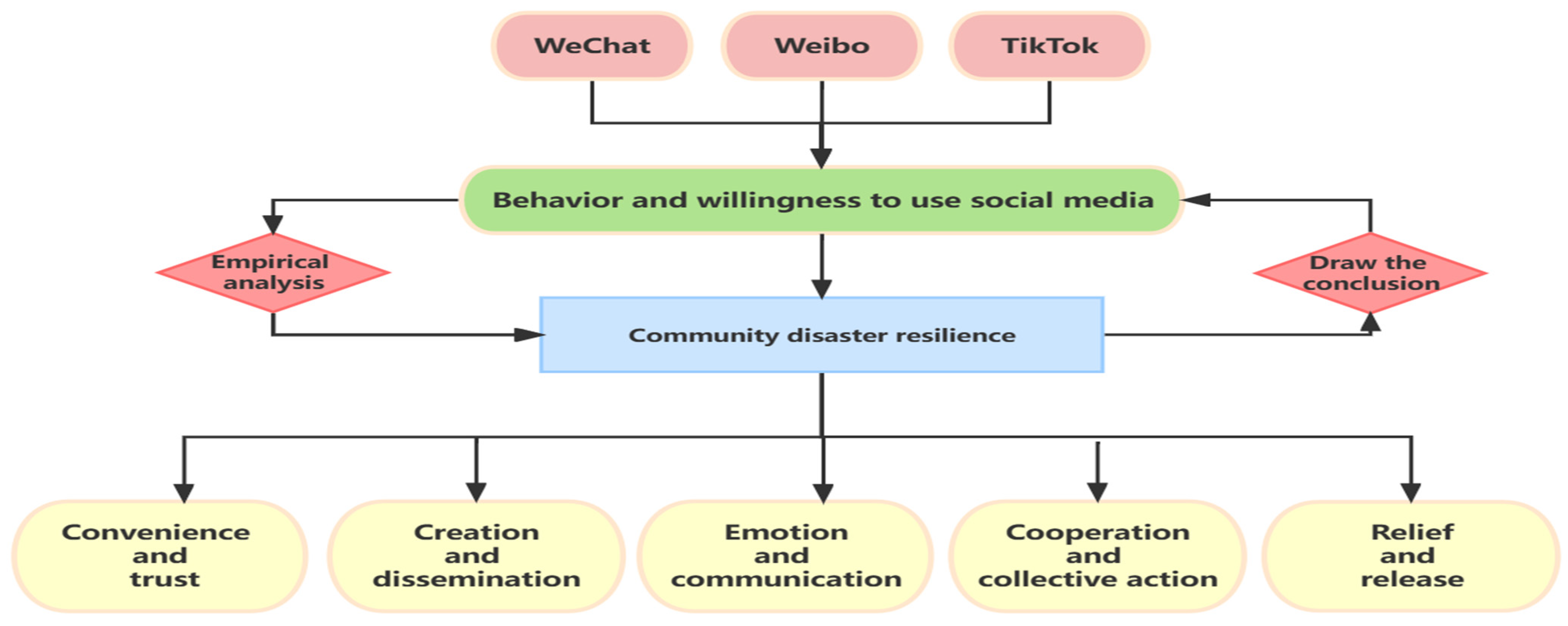
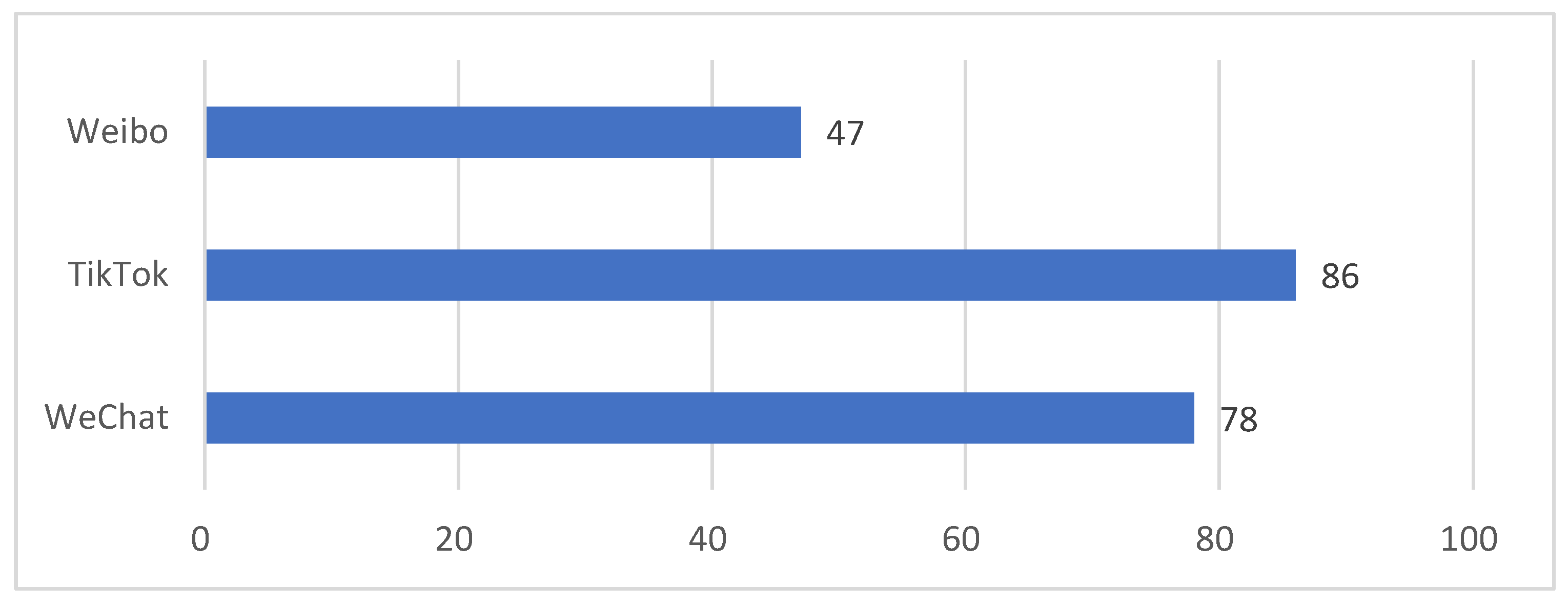
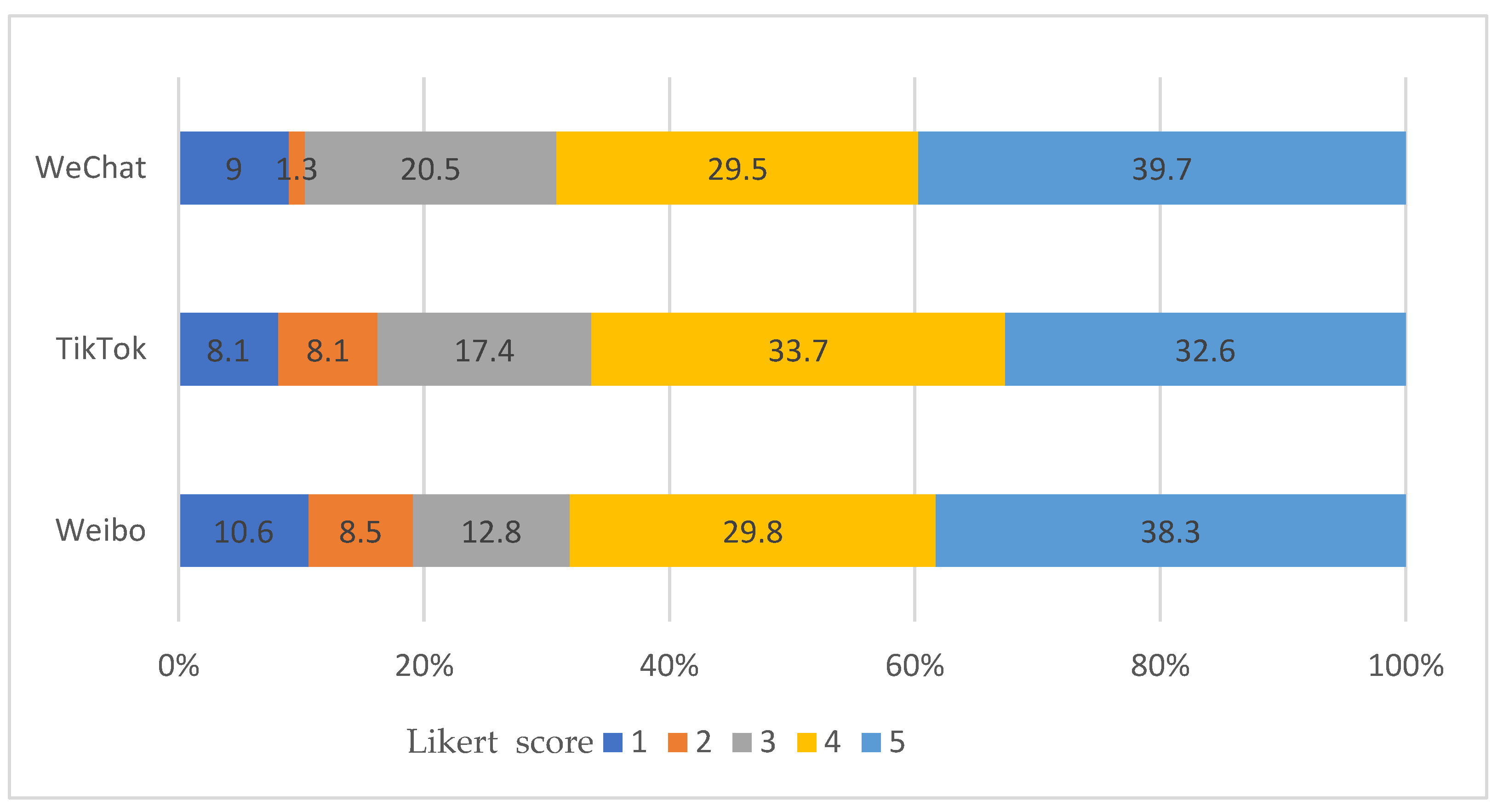
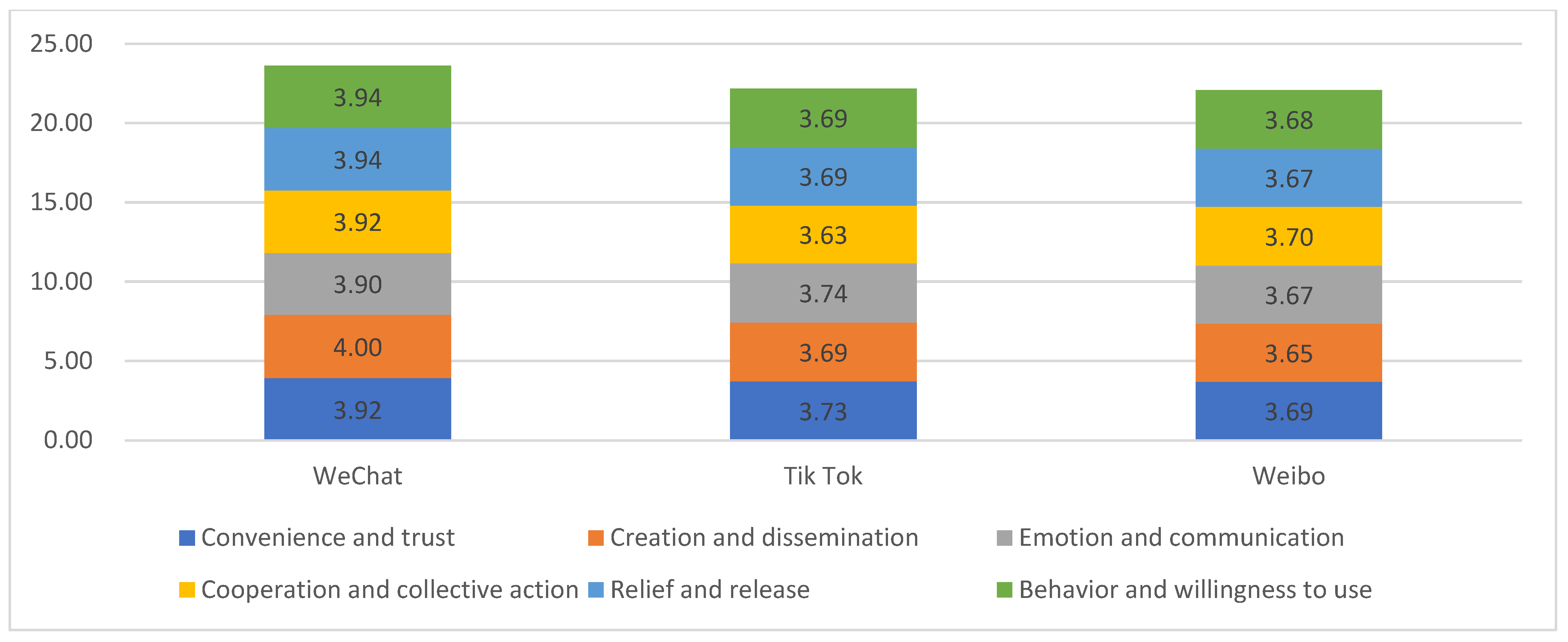
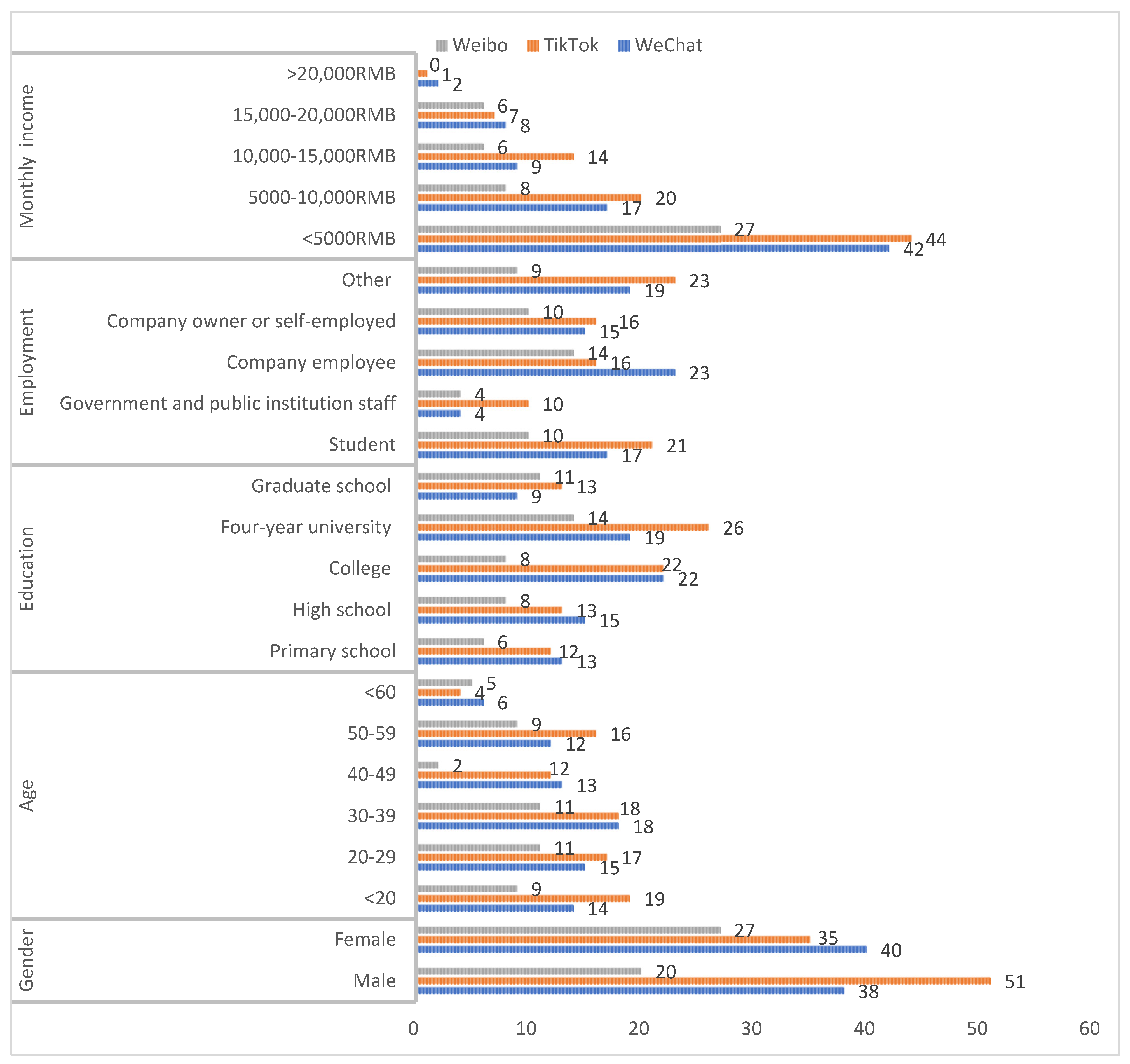
| Characteristics | Frequency | Percent (%) | |
|---|---|---|---|
| Gender | Male | 109 | 51.66 |
| Female | 102 | 48.34 | |
| Age | <20 | 42 | 19.90 |
| 20–29 | 43 | 20.40 | |
| 30–39 | 47 | 22.30 | |
| 40–49 | 27 | 12.80 | |
| 50–59 | 37 | 17.54 | |
| <60 | 15 | 7.11 | |
| Education | Primary school | 31 | 14.70 |
| High school | 36 | 17.06 | |
| College | 52 | 24.64 | |
| Four-year university | 59 | 28.00 | |
| Graduate school | 33 | 15.64 | |
| Employment | Student | 48 | 22.75 |
| Government and public institution staff | 18 | 8.53 | |
| Company employee | 53 | 25.12 | |
| Company owner or self-employed | 41 | 19.43 | |
| Other | 51 | 24.17 | |
| Monthly income | <5000 RMB | 113 | 53.60 |
| 5000–10,000 RMB | 45 | 21.30 | |
| 10,000–15,000 RMB | 29 | 13.74 | |
| 15,000–20,000 RMB | 21 | 10.00 | |
| >20,000 RMB | 3 | 1.40 | |
| Concept | Items Measuring the Concept | Reliability |
|---|---|---|
| Convenience and trust | It is convenient to use (WeChat/Weibo/TikTok) to get disaster information. | 0.831 |
| I can use (WeChat/Weibo/TikTok) to send help information. | ||
| I can use (WeChat/Weibo/TikTok) to receive information about disaster response, recovery, and reconstruction. | ||
| Creation and dissemination | I can use (WeChat/Weibo/TikTok) to record and understand what happened. | 0.858 |
| I can use (WeChat/Weibo/TikTok) to post or forward information about the disaster information. | ||
| I can use (WeChat/Weibo/TikTok) to get relief supplies or help others to get relief supplies. | ||
| Emotion and communication | I can use (WeChat/Weibo/TikTok) to get emotional support and psychological comfort. | 0.845 |
| I can use (WeChat/Weibo/TikTok) to express worry and sympathy for friends and relatives. | ||
| I can use (WeChat/Weibo/TikTok) to help more people, which can make me feel happy, and thus get emotional satisfaction. | ||
| Cooperation and collective action | I can use (WeChat/Weibo/TikTok) to help people in need. | 0.851 |
| I can use (WeChat/Weibo/TikTok) to win the appreciation and recognition of others. | ||
| I can use (WeChat/Weibo/TikTok) to post relevant information to establish or maintain a social relationship with others. | ||
| Relief and release | I can use (WeChat/Weibo/TikTok) to listen to others or talk to others about the rainstorm. | 0.845 |
| I can use (WeChat/Weibo/TikTok) to (re)post information, pictures, videos, etc. to relieve the fear and tension caused by rainstorm disasters. | ||
| I can use (WeChat/Weibo/TikTok) to (re)send relevant information to commemorate the victims of the accident. | ||
| Behavior and willingness to use | Overall, I am satisfied with the experience of using (WeChat/Weibo/TikTok) to get disaster information. | 0.835 |
| I will use (WeChat/Weibo/TikTok) to get disaster information when I face a disaster again. | ||
| I would suggest my friends and relatives use (WeChat/Weibo/TikTok) to get or post-disaster information in case of disasters. |
| Model | Unstandardized Coefficients | Standardized Coefficients | t | Sig. | R2 | ||
|---|---|---|---|---|---|---|---|
| Independent Variable | Dependent Variable | B | Std. Error | Beta | |||
| Behavior and willingness to use WeChat | Convenience and trust | 0.819 | 0.075 | 0.781 | 10.906 | 0.000 | 0.61 |
| Creation and dissemination | 0.815 | 0.068 | 0.809 | 12.007 | 0.000 | 0.655 | |
| Emotion and communication | 0.874 | 0.072 | 0.813 | 12.160 | 0.000 | 0.661 | |
| Cooperation and collective action | 0.883 | 0.067 | 0.834 | 13.192 | 0.000 | 0.696 | |
| Relief and release | 0.790 | 0.070 | 0.791 | 11.262 | 0.000 | 0.625 | |
| Behavior and willingness to use Weibo | Convenience and trust | 0.703 | 0.073 | 0.821 | 9.635 | 0.000 | 0.674 |
| Creation and dissemination | 0.718 | 0.088 | 0.774 | 8.187 | 0.000 | 0.598 | |
| Emotion and communication | 0.851 | 0.060 | 0.903 | 14.138 | 0.000 | 0.816 | |
| Cooperation and collective action | 0.856 | 0.066 | 0.887 | 12.875 | 0.000 | 0.787 | |
| Relief and release | 0.756 | 0.062 | 0.876 | 12.188 | 0.000 | 0.767 | |
| Behavior and willingness to use TikTok | Convenience and trust | 0.939 | 0.057 | 0.875 | 16.539 | 0.000 | 0.765 |
| Creation and dissemination | 0.935 | 0.055 | 0.878 | 16.853 | 0.000 | 0.772 | |
| Emotion and communication | 0.930 | 0.058 | 0.869 | 16.109 | 0.000 | 0.755 | |
| Cooperation and collective action | 0.936 | 0.067 | 0.837 | 14.009 | 0.000 | 0.700 | |
| Relief and release | 0.949 | 0.065 | 0.848 | 14.646 | 0.000 | 0.719 | |
Disclaimer/Publisher’s Note: The statements, opinions and data contained in all publications are solely those of the individual author(s) and contributor(s) and not of MDPI and/or the editor(s). MDPI and/or the editor(s) disclaim responsibility for any injury to people or property resulting from any ideas, methods, instructions or products referred to in the content. |
© 2023 by the authors. Licensee MDPI, Basel, Switzerland. This article is an open access article distributed under the terms and conditions of the Creative Commons Attribution (CC BY) license (https://creativecommons.org/licenses/by/4.0/).
Share and Cite
Zhai, L.; Lee, J.E. Harnessing ICT Resources to Enhance Community Disaster Resilience: A Case Study of Employing Social Media to Zhengzhou 7.20 Rainstorm, China. Water 2023, 15, 3516. https://doi.org/10.3390/w15193516
Zhai L, Lee JE. Harnessing ICT Resources to Enhance Community Disaster Resilience: A Case Study of Employing Social Media to Zhengzhou 7.20 Rainstorm, China. Water. 2023; 15(19):3516. https://doi.org/10.3390/w15193516
Chicago/Turabian StyleZhai, Linpei, and Jae Eun Lee. 2023. "Harnessing ICT Resources to Enhance Community Disaster Resilience: A Case Study of Employing Social Media to Zhengzhou 7.20 Rainstorm, China" Water 15, no. 19: 3516. https://doi.org/10.3390/w15193516
APA StyleZhai, L., & Lee, J. E. (2023). Harnessing ICT Resources to Enhance Community Disaster Resilience: A Case Study of Employing Social Media to Zhengzhou 7.20 Rainstorm, China. Water, 15(19), 3516. https://doi.org/10.3390/w15193516







